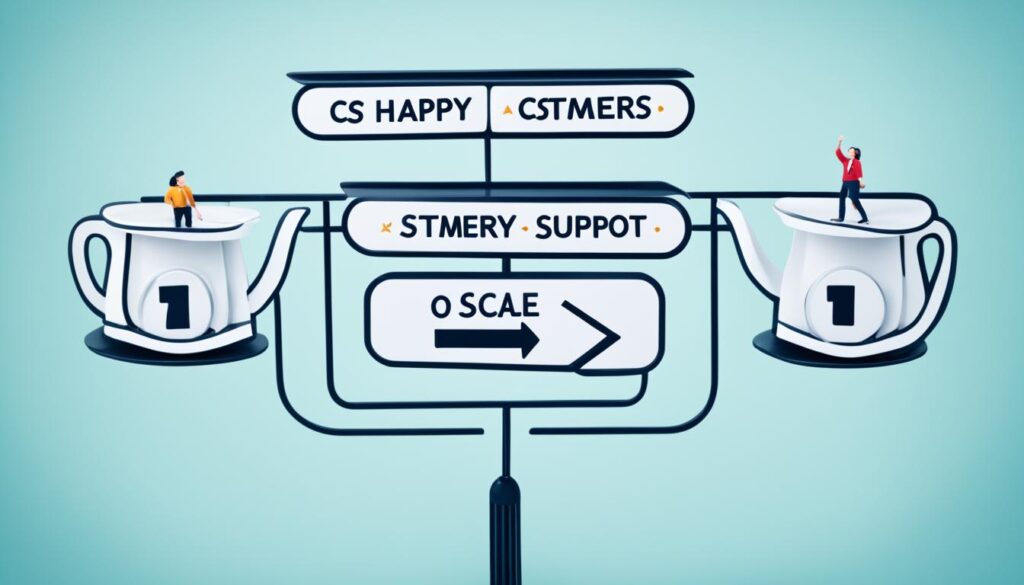Welcome to the world of swarming tiered support, an efficient and dynamic approach that can transform your helpdesk into a collaborative powerhouse. If you’re tired of traditional support models that lead to ticket backlogs and limited skill-sharing, it’s time to consider a new strategy.
Swarming support eliminates the need for tiers and escalation protocols, allowing your customers to connect directly with the right person to solve their problems. Instead of bouncing between different support levels, your team members collaborate and share their expertise to provide agile and effective solutions.
With swarming support, you can say goodbye to ticket queues and hello to faster resolutions. By bringing together the collective knowledge and skills of your team members, you create a support model that is responsive, efficient, and customer-focused. Whether you have a small or large customer service team, swarming support can revolutionize the way you deliver exceptional service.
Are you ready to adopt a more collaborative and dynamic support approach? In the following sections, we will explore the benefits and considerations of both swarming support and traditional tiered support. By understanding the pros and cons of each model, you can make an informed decision and choose the support model that best suits your team’s needs and resources. Let’s dive in and discover how swarming tiered support can revamp your helpdesk and take your customer service to new heights.
Understanding Traditional Three-Tiered Support
The traditional support model for customer service often utilizes a three-tiered technique that involves support tiers. In this model, the first-tier handles incoming calls or messages and addresses simple problems. They serve as the initial point of contact for customers. If the issue is more complex, the problem is escalated to the second-tier, where specialized support specialists and service desk-focused individuals step in. These individuals possess in-depth knowledge and expertise to handle more challenging customer queries. Lastly, the third-tier consists of highly trained individuals who specialize in specific tasks or technologies, addressing the most intricate and complex issues.
While the three-tiered model has been widely adopted, it is not without its challenges. One drawback is that it can lead to massive queues and ticket backlogs. The first-tier can become overwhelmed with widespread problems, causing delays in resolution times. Additionally, the traditional support model lacks opportunities for skill-sharing and training among team members, which can hinder growth and efficiency.
In the traditional three-tiered support model, the distribution of workload and expertise is typically structured, ensuring that issues are addressed by the appropriate individuals. However, it can also result in delays and inefficiencies when faced with complex customer issues.
Challenges of the Traditional Support Model
“The three-tiered support model offers specialized expertise, but it can create delays, overwhelm the initial support tier, and lacks skill-sharing opportunities.” – Customer Support Expert
Despite its limitations, the traditional support model has proven to be effective for many services and companies with large customer service staff. It provides clear boundaries and defined roles, allowing for efficient routing of customer queries based on complexity.
Next, we will explore an alternative support model that revolutionizes the way customer service teams handle complex issues. Swarming support, as we will discover, prioritizes collaboration and direct problem-solving for a more efficient and effective customer support experience.

Introducing Swarming Support
Swarming support is a revolutionary approach that eliminates tiers and escalation protocols in customer service. Instead of waiting for calls or messages to be escalated, swarm service agents monitor incoming tickets and directly address the ones they can easily solve. This approach promotes collaboration and skill-sharing among team members, encourages direct problem-solving, and reduces or eliminates ticket backlogs.
Swarming support is particularly effective for faster resolutions and handling complex issues. By allowing agents to address tickets directly, without the need for escalation, customers receive immediate attention and solutions to their problems. This streamlined approach ensures that no time is wasted waiting for issues to be passed along to the next tier of support, resulting in quicker resolution times and increased customer satisfaction.
One of the key benefits of swarming support is the promotion of collaboration and skill-sharing among team members. With the elimination of strict tiers, agents from different disciplines and skill levels can work together, sharing their expertise to resolve complex issues more efficiently. This collaborative environment fosters knowledge transfer and allows agents to learn from each other, leading to an overall improvement in the team’s capabilities.
“Swarming support has transformed the way we handle customer issues. The ability to address tickets directly and collaborate with my colleagues has significantly improved our response time and resolution rate.”
However, implementing swarming support can require a significant shift in working style and may be more challenging to manage in big companies or with large teams. Without clear guidance and effective communication channels, collaboration among agents may become challenging, and coordination efforts may be required to ensure smooth operations.
In summary, swarming support is a customer service approach that promotes direct problem-solving, collaboration, and skill-sharing. It streamlines the ticket resolution process, reduces backlogs, and enables faster resolutions for complex issues. While it may require adjustments and careful management, the benefits it brings to customer service teams make it a compelling option to consider.
Pros and Cons of Three-Tiered Support
Three-tiered support has its pros and cons. Let’s take a closer look at the advantages and drawbacks of this support model.
Pros of Three-Tiered Support
- Limited training: Tier-one employees require minimal training as they handle simple problems and frequently encountered issues.
- Specialists’ focus: The tiered structure ensures that highly skilled specialists are not tied up with basic inquiries, allowing them to concentrate on complex problems.
- Specialists availability: Finding and retaining specialists is easier with the tiered support model, as their specific expertise can be utilized efficiently.
Cons of Three-Tiered Support
- Massive queues and ticket backlogs: The first tier often experiences overwhelming ticket volumes due to widespread problems, resulting in long waiting times and dissatisfied customers.
- Lack of skill-sharing and training opportunities: Without a collaborative approach, knowledge sharing and skills development among team members may be limited, leading to stagnant growth.
- Challenges for small customer service staff: Implementing a three-tiered system in companies with a small customer service staff can be impractical and inefficient, given the need for specialization and diverse skills.
It’s important to carefully evaluate these pros and cons to determine whether the three-tiered support model is suitable for your organization’s specific needs and resources.

Pros and Cons of Swarming Support
Swarming support offers several advantages and some disadvantages. Let’s take a closer look:
Pros of Swarming Support
- Faster resolutions: With swarming support, issues are addressed directly by the most appropriate team member, leading to quicker problem-solving and resolution times.
- Reduced ticket backlogs: By eliminating tiers and allowing team members to directly address incoming tickets, swarming support helps prevent ticket backlogs from piling up.
- Collaboration and skill-sharing: The collaborative nature of swarming support fosters team collaboration and skill-sharing, enhancing overall team efficiency and effectiveness.

Cons of Swarming Support
- Shift in working style: Implementing swarming support may require a significant shift in working style for your team, which can be challenging to adapt to, especially for large companies or teams.
- Mundane issues consuming skilled specialists’ time: As swarming support allows team members to address tickets directly, skilled specialists might find themselves spending time on mundane or straightforward issues instead of focusing on more complex problems.
- Managing collaboration and coordination: In larger groups, managing the collaboration and coordination required for effective swarming support can be more difficult compared to smaller teams.
| Pros | Cons |
|---|---|
| Faster resolutions | Shift in working style |
| Reduced ticket backlogs | Mundane issues consuming skilled specialists’ time |
| Collaboration and skill-sharing among team members | Managing collaboration and coordination |
Choosing the Right Support Model for Your Team
When it comes to selecting the right support model for your team, there are several factors to consider. First and foremost, take into account the size of your team. If you have a smaller team, swarming support may be the ideal choice. Swarming support promotes collaboration among team members, leading to faster resolutions and a reduction in ticket backlogs.
On the other hand, if you have a larger team and often deal with repetitive inquiries, a tiered support model may be more suitable. However, it’s important to note that tiered support can result in longer resolution times for high-priority incidents.
To make an informed decision, assess both the strengths and limitations of each support model. Consider factors such as ticket volume, self-service capabilities, and product velocity. By doing so, you can determine which support model aligns best with your team’s needs and available resources.
Once you’ve chosen a support model, it’s crucial to implement a well-defined strategy and document best practices. This ensures a smooth implementation process and effective delivery of support services.
FAQ
What is swarming tiered support?
Swarming tiered support is an innovative approach that eliminates tiers and escalation protocols in customer service. It allows customers to connect directly with the person most likely able to solve their problem, encouraging collaboration and skill-sharing among team members and offering faster resolutions.
How does swarming support differ from the traditional tiered support model?
Unlike the traditional tiered support model, swarming support eliminates tiers and allows customers to connect directly with the person most likely able to solve their problem. This approach promotes efficiency, knowledge sharing, and faster resolution times.
What are the advantages of swarming support?
Swarming support offers several advantages, including faster resolutions, reduced or eliminated ticket backlogs, and enhanced collaboration and skill-sharing among team members. It allows for a more efficient customer service experience and is particularly effective for handling complex issues.
Does swarming support have any disadvantages?
Swarming support may require a significant shift in working style and can be more challenging to manage in big companies or with large teams. Skilled specialists may find their time absorbed by mundane or straightforward issues, and it can be difficult to manage the collaboration and coordination required in large groups.
What are the pros and cons of the traditional three-tiered support model?
The pros of the three-tiered support model include limited training required for tier-one employees and the ability to keep specialists from being tied up with simple problems. However, this model can lead to massive queues and ticket backlogs, overwhelm the first tier with widespread problems, and lack skill-sharing and training opportunities.
How should I choose the right support model for my team?
When choosing the right support model for your team, consider factors such as team size, ticket volume, self-service capabilities, and product velocity. If you have a smaller team, swarming support may be a better fit as it promotes collaboration, faster resolutions, and reduces ticket backlogs. Tiered support works well for larger teams and repetitive inquiries but can lead to longer resolution times for high-priority incidents.
